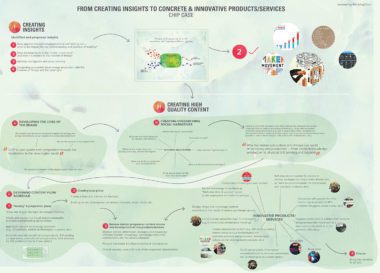Author: Lena Müller-Naendrup
Climate change is one of the most pressing global issues of our time, with its devastating effects felt by communities worldwide. The sheer complexity of the problem can leave us feeling helpless and overwhelmed. Nevertheless, there is a widespread belief that technology is the key to solving the devastating climate crisis. Various technological solutions such as carbon capture, hydrogen power, nuclear fusion, and e-fuels are often presented as the cure-all for our environmental problems.
However, these solutions are usually not embedded in the bigger picture of the complex nature of climate change. They are considered in isolation and often as competing alternatives.
Tackling climate change requires systemic awareness and change, meaning that technology becomes just one piece of the puzzle in a holistic solution. Only in such a context can the purpose of technology unfold: technology-driven solutions to climate change can only bring about meaningful change if we consider them in terms of their purpose rather than their technical makeup.
While technological solutions, ranging from the development of vaccines to the invention of the Internet, have brought undeniable benefits to society, it is essential to critically examine how technological artifacts can be deployed to provide a purposeful and sustainable answer to the climate crisis.
In this blog post, we explore the pitfalls of ‘letting the hardware do the talking’. Instead, we suggest thinking about technology from a purpose perspective – this is the only way we can bring about a radical and meaningful future rather than being constrained by technological limitations from the outset.
Geoengineering: A Magic Bullet Solution to Climate Change?
In his recent novel “The Ministry for the Future”, the American author Kim Stanley Robinson writes about several geoengineering attempts by international governments and scientists to combat the ongoing climate catastrophes. In one such scenario, scientists devise elaborate methods for removing melted water from underneath glaciers at the poles to prevent it from flowing into the sea.
While this scenario is part of a fictitious story, plenty of similar projects are currently led by different research institutes or startups around the world. From solar engineering projects that try to release calcium carbonate particles into the stratosphere to reflect more of the sun’s heat back into space to already more widespread carbon-capturing technologies, geoengineering has recently attracted growing attention among researchers, politicians, and investors.
Wealthy techno-enthusiasts such as Bill Gates or Elon Musk have already invested billions of dollars into diverse geoengineering projects, driven by the belief that climate change is the next crisis to be resolved by technological innovation – all telling the innovation story of neat engineering fixes that are solving most of life’s ills.
This thinking perfectly aligns with what the American-Belarusian writer Evgeny Morozov criticizes as techno-solutionism. Techno-solutionism, in its simplest form, holds that in times of no alternative, the best we can do is to apply a digital plaster to the damage. Thus, techno-optimists believe that, given the right robot, code, or algorithm, technology can effectively solve most of our problems.
But can technological fixes really offer a magic bullet solution to climate change?
The E-Fuel Paradox
A technological innovation that has recently gained significant attention from the general public and media is synthetically produced e-fuels. As couple of weeks ago, a long-planned EU legislation to ban combustion engine cars from Europe’s roads by 2035 was watered down by an exemption for engines powered by e-fuels, a heated discussion evolved around the question of hasty technological innovations as a way to cut down emissions.
E-fuels, also known as synthetic fuels or electro-fuels, come from a process of electrolysis that splits water (H2O) into hydrogen (H) and oxygen (O). The hydrogen is mixed with carbon dioxide (CO2) to produce the liquid form of the e-fuel, which is further refined into e-petrol, e-diesel, or e-kerosene.
Unfortunately, at the current state of research, the whole production process is still very energy intensive. Furthermore, to be CO2-neutral, producing e-fuels must primarily be powered by renewable electricity sources. Despite that, the production capacities for e-fuels are still very limited and will barely cover the demands of road traffic.
Experts have raised concerns regarding the efficiency of e-fuels as sustainable alternatives to combustion engines. They argue that investing money and time into establishing an e-fuel supply for road traffic will take away necessary resources to further develop the technology so that it can be efficiently and sustainably implemented in other sectors, such as the aviation and shipping sectors.
Thus, the allowance of e-fuel combustion engines not only creates additional unresolved challenges but also hinders the automotive industry, as well as the EU’s Directorate General for Mobility and Transport, from developing radically innovative ways to sustainably reduce emissions in the mobility sector.

The Allure of Simplicity
The above example of e-fuels illustrates the flaw in relying on technological quick fixes to address climate change, as they often fall prey to hasty solutions. While remaining receptive to new ideas and innovations is crucial, premature implementations of untested technologies can lead to unintended consequences. For instance, the long-term effects of releasing calcium carbon particles into our stratospheres to reflect sunlight are largely unknown. Hence, deploying solar engineering projects at a large scale could result in unforeseeable alterations to local ecosystems.
However, the e-fuel debate also highlights another problem: Technological quick-fixes can allure us into seemingly simple and convenient answers that may distract political pressure and popular will from addressing the root causes of the issues. Proponents of e-fuels argue that they can cut road traffic emissions and facilitate the emergence of new technologies, but it turns out that this line of reasoning is problematic.
To significantly reduce emissions from road traffic, we must undergo a comprehensive transformation of the entire transport sector. Rather than simply adapting the existing model to a marginally less pollutive alternative, we should use this ambitious goal as an opportunity to fundamentally rethink how we move and travel. Sticking with the same framework, which relies on private cars in this context, is a significant obstacle to meaningful change. Embracing e-fuels as a way out offers a convenient option to avoid the strenuous challenge of restructuring road traffic.
Staying With the Trouble
But how and why should we resist the temptation of technological quick fixes, especially when time is scarce, change is urgent, and some environmental catastrophes are already inevitable?
As mentioned earlier, the sheer complexity of global, urgent problems and problems like the climate crisis often leave us feeling overwhelmed and powerless. Yet, it is precisely this complexity that demands our unwavering attention.
The prominent American Professor of science and technology studies, Donna Haraway, argues that we need to “stay with the trouble” and resist the urge to simplify complex problems. Instead, we must embrace the intricate messiness of the world we live in.
Every problem arises within a specific context, with a web of interconnected factors and potential solutions. To truly engage in radical innovation and stay with the trouble, we must invest sufficient time to deeply understand the dynamics and nuances of the problem at hand.
Merely pursuing solutions that seem to be in relatively easy reach only perpetuates the cycle of the “more-of-the-same”. We must break free from this loop by shifting our focus from the pursuit of solutions to a purpose-driven examination of the problem context. This involves questioning the status quo, challenging preconceived notions, and unearthing new, unexpected ways of thinking.
To move away from the pitfalls of hasty technological quick-fixes and embrace purposeful innovation, we want to share some first tips and advice to help you embark on a path of purposeful innovation:
- Question your questions: Avoid jumping to conclusions and solutions. Instead, start by disassembling the problem you are trying to solve. You may discover more fundamental issues and questions underlying your main problem.
- Embrace the journey: Purposeful innovation takes time; don’t rush the process. Beware of simplistic all-in-one solutions. Critically evaluate such solutions first. Investing time in understanding the core problem will pay dividends in the end, creating a wide web of approaches instead.
- Don’t be intimidated by reality: Complex problems require diverse and bold thinking. Don’t shy away from multifaceted challenges; firstly, interdisciplinarity is key to tackling complex issues. Second, focus on your vision rather than on existing constraints.
- Stay focused: Make sure your solution is in line with its original purpose. There is a reason why we use certain technologies – and it is not for their own sake. Let purpose guide your innovation journey.
In a world of hasty technological fixes and superficial solutions, genuine innovation lies in purpose-driven technology. We believe in challenging the status quo together with our clients, asking deep questions, and embracing the complexity of real-world issues. With an unwavering focus on purpose, meaningful innovation can redefine what’s possible: this is how we will create technology that makes a lasting impact for the good of the planet.
We’ll have more to say about our purposeful technology approach in the future. Hence, if you’re interested, feel free to subscribe to our newsletter below.
Subscribe to Our Newsletter
Keep your innovative edge with more stories like this and additional reading tips, muses, and project updates.
References
- https://earth.org/techno-optimism/
- https://worldwise.substack.com/p/gates-climate-technosolutionism
- https://thebreakthrough.org/ecomodernism
- https://www.technologyreview.com/2021/02/16/1017832/gates-robinson-kolbert-review-climate-disaster-solutionism/
- https://www.un.org/en/climatechange/raising-ambition/renewable-energy
- https://www.forbes.com/sites/arielcohen/2021/01/11/bill-gates-backed-climate-solution-gains-traction-but-concerns-linger/?sh=4306efe8793b
- https://www.euronews.com/my-europe/2023/03/07/the-eus-new-debate-are-e-fuels-a-viable-and-green-alternative-to-the-combustion-engine
- https://www.efuel-alliance.eu/efuels/what-are-efuels
- HARAWAY, D. J. (2016). Staying with the Trouble: Making Kin in the Chthulucene. Duke University Press. https://doi.org/10.2307/j.ctv11cw25q
Images by USGS and Murilo Silva @ unsplash


